The Beginner’s Guide to Growing Your Website With Pay-Per-Click (PPC) Advertising

In just one second — about the time it took you to read that first phrase — there were nearly 70,000 searches happening on the internet.
In real time, the numbers are staggering.
With so many clicks occurring every second, it’s virtual rush hour on the interwebs. And you website owners out there should be making the most of the digital crowds. You want clicks on your site and customers engaging with your brand.
So how can you get in front of customers’ searches? Pay-per-click advertising (PPC).
What Is PPC and How Does It Work?
Before we delve in, let’s start with the most basic of basics: a simple search. Say you want to buy some office supplies. Here’s what Google would come up with.
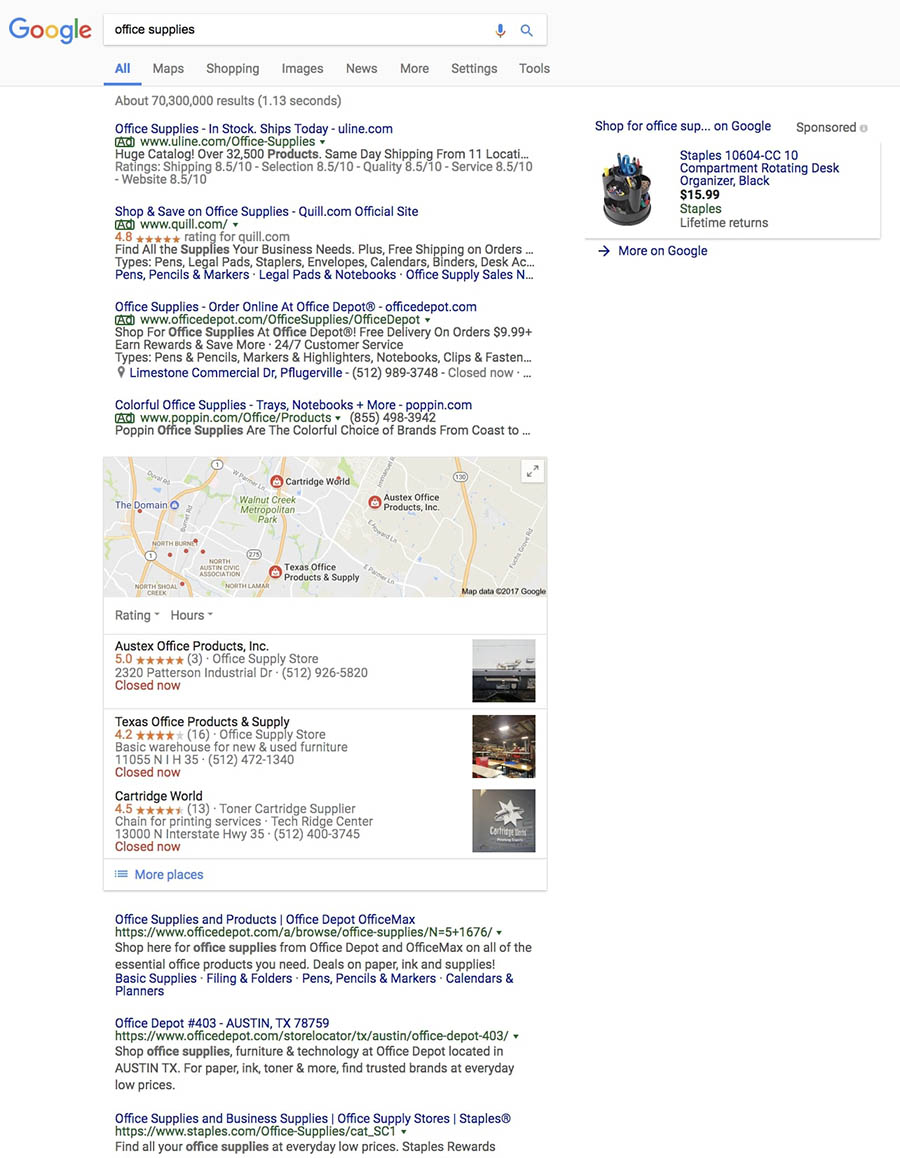
As you can see, there are a few results above the fold (the part of the page you can see without scrolling) and results below the fold. The first few results (and the result to the right) are designated as “Ad” or “Sponsored.” The distinctions on the results show us which are paid results and which are organic.
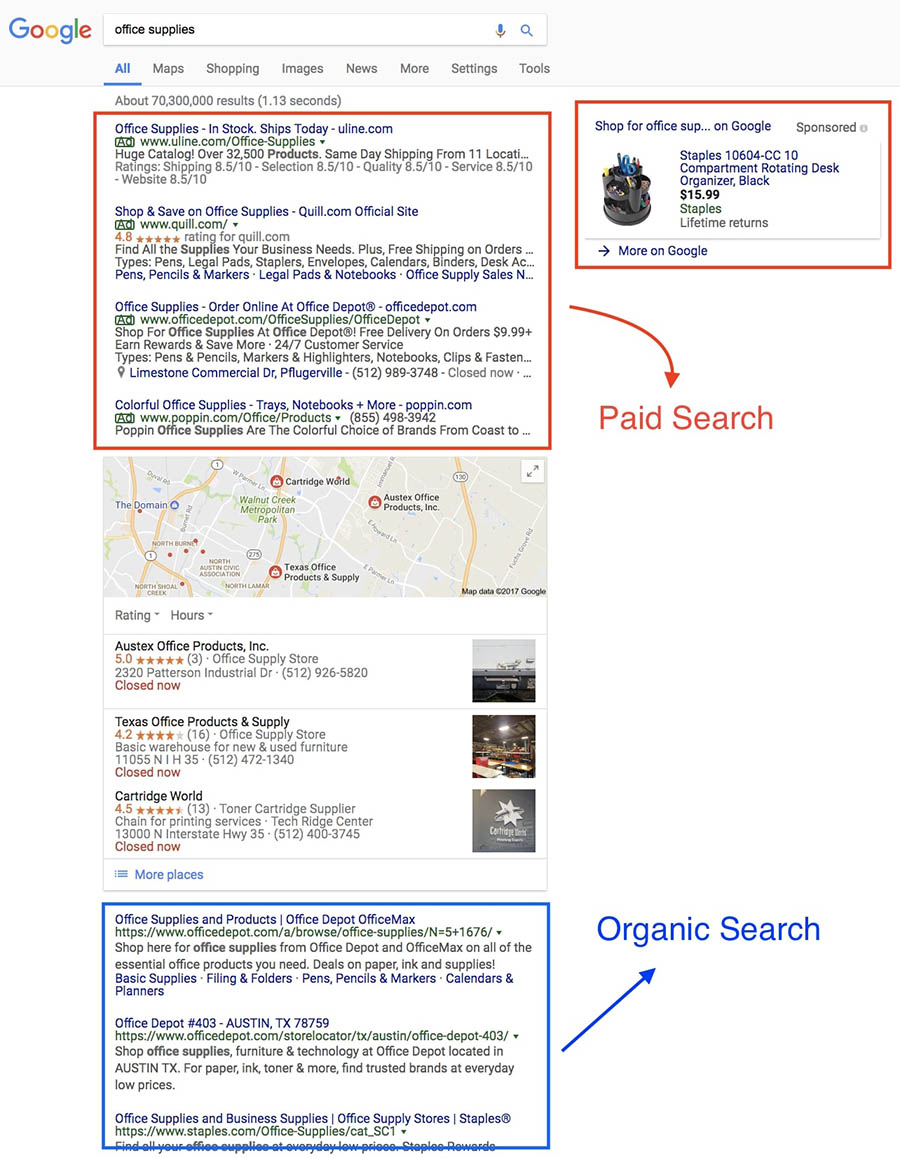
As you probably know, organic search results are the sites that come up because they are pertinent based on their keywords, SEO strategy, fresh content, and responsive design. Trust us, Google’s algorithm is as wide and expansive as Ariana Grande’s vocal range — four octaves, people!
Paid search — as the name suggests — involves paying $$$ to have your website appear in the sponsored sections of search engine results and corresponding partner sites.
Both organic and paid searches appear in search results, just in different locations. PPC allows you to have your website appear in the sponsored/ad results, but the best part?
You only pay for it when someone clicks on your ad! Genius, right?
So how do you get started? And why should you? Good questions. Let’s dig in.
We take the guesswork (and actual work) out of growing your traffic through search engine optimization.Website PPC Made Easy

Start With Google AdWords
Oh, Google AdWords, how we love thee. Let us count the ways. Or at least, let’s talk about why it’s a good place to start your paid search advertising journey:
- First of all, Google is Google so you know you’re dealing with a reputable search engine. Plus, Google provides you with helpful tools (like its Keyword Planner, a help center, best practices literature, resources, and even another advertising option: Adwords Express — if you’re looking for a more managed paid search experience).
- AdWords is scalable to your budget (more on that later). No need to stress about overblowing your expenses on pricey advertising packages. Plus, you only pay when you get clicks, and you can start small.
- With AdWords, you can easily keep track of your stats and results; your progress is transparent and measurable. With accessible monitoring, you can continually improve your campaign performance and see better traffic (we’ll talk success metrics later).
- With PPC, you can hyper-target specific audiences with a variety of match types, increasing your chances of converting relevant customers. AdWords also provides you with many engaging campaign formats — like graphic display ads, YouTube video ads, text-based ads and more — that are easy to manage and track day-to-day.
- PPC with Google AdWords can get you clicks and impressions — fast. For example, say Black Friday is approaching and you need more traffic to your site, like, *yesterday*. With AdWords, you can start getting that traffic and building brand awareness right now without having to wait for the results of traditional SEO drivers. Think of PPC like a shot of adrenaline. It’s a fast fix, but you’ll also need to complement it with a long-term search engine optimization strategy.
- Unlike pop-up ads or annoying clickbait, PPC through AdWords is an unobtrusive advertising method, occurring during an internet user’s routine web browsing and searching.
- If we haven’t convinced you to get started with AdWords, maybe your competitors will: 72 percent of AdWords marketers plan to increase their PPC budgets. If you’re not on board, you’re getting left behind — and losing out on prime internet real estate.
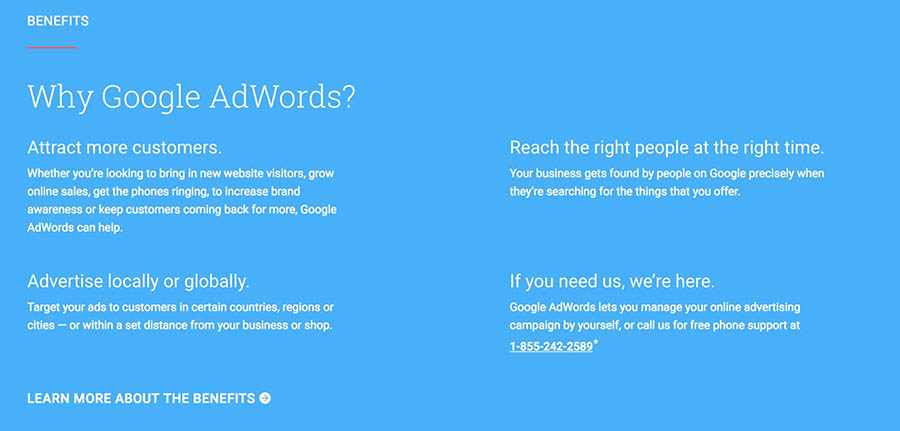
As more space is awarded to ads above the fold than organic results, you have an opportunity to have highly clickable content reach your specific audiences. Now, let’s get to work!
Create Your AdWords Account and Build a Strategy
Getting started with Google AdWords is pretty simple. Visit the Google AdWords homepage and click “Start Now.” You’ll begin by logging in with an email address and your site URL. If you’ve got questions, check out Google’s in-depth guide. And remember, if you mess up while creating your account, Google AdWords has specialists on call!
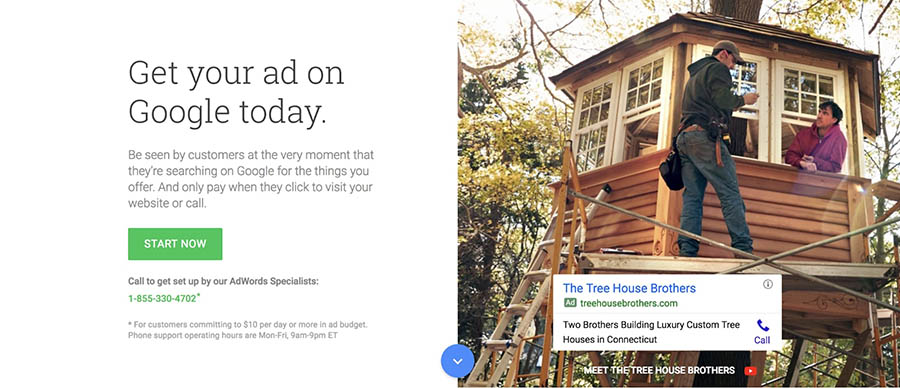
Now that you’re set up with an account, you should think strategy before you begin developing your campaigns. A good place to start is by determining your PPC campaign goals. Ask yourself these questions:
- Who (specifically) are you targeting?
- What outcome do you want?
- What do you want your target audience to do?
- How will your campaign be a success?
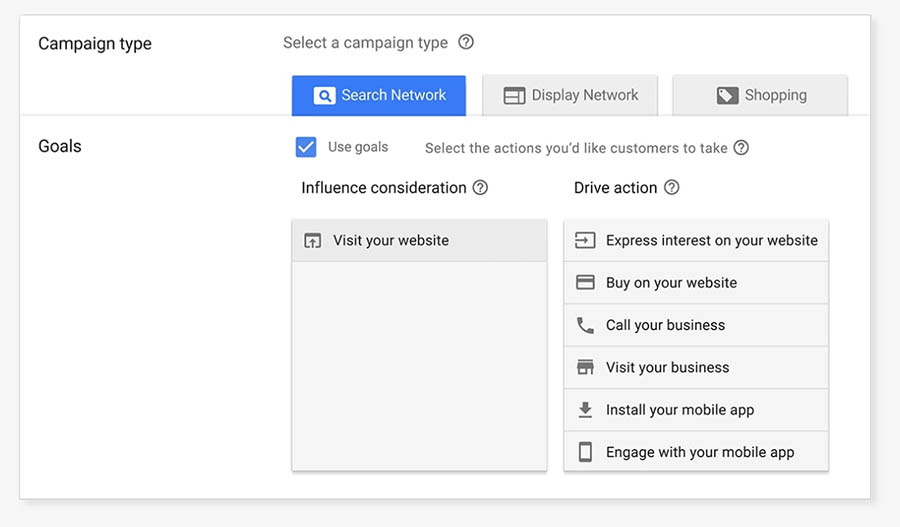
Answering questions like these can help you guide your campaign choices and plan a kick-butt advertising gameplan.
Setting an AdWords Budget
In terms of $$$, AdWords offers a great amount of flexibility based on your budget. An auction-style bidding method sets prices for keywords (all that time you spent playing Masterpiece is *finally* coming in handy!) so you get to decide how much you’re willing to pay for each click by bidding for your chosen keywords.
AdWords then uses an algorithm called Ad Rank to determine where your ads will be shown on a page (or if they’ll even be shown at all).
From Google: “Ad Rank is calculated using your bid amount, the components of Quality Score — expected clickthrough rate, ad relevance, and landing page experience — and the expected impact of extensions and other ad formats.”
That means that if you want to improve the position of your ad on the page (i.e. move that puppy above the fold), you’re going to have to do the following:
- Increase your bid.
- Improve the quality of your ads.
- Improve the quality of your computer and mobile landing pages.
We’ll cover those last two points a little later. For now, let’s talk a bit more about maximizing your bidding budget.
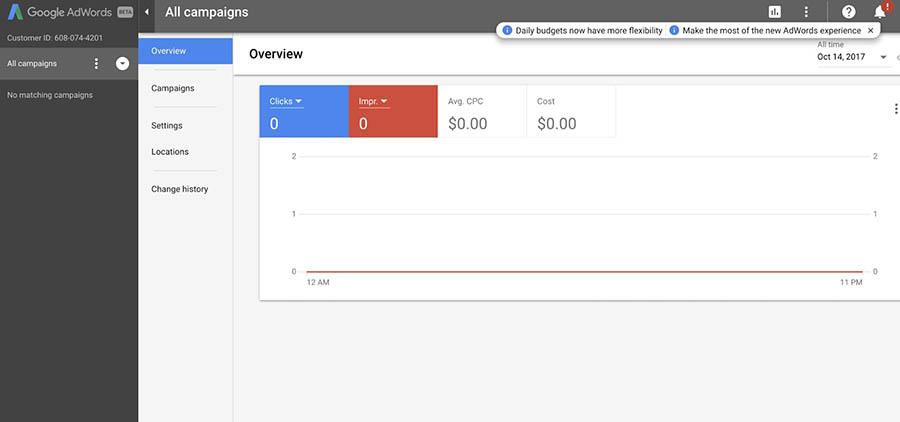
AdWords is a very manageable start-where-you’re-at marketing strategy — bootstrappers, rejoice! It works with your budget.
Instead of forking over a wad of cash every time you get a click or blowing your ad budget in one go, you can set up your account to work within a daily budget, dictating how much money Google can spend on your ad placements each day. You can also request to have your budget spread across the entire day to capitalize on clicks at different times.
To learn more, check out Google’s guide on setting up your first AdWords bid.
Remember: if you’re just starting out with paid advertising or your budget is tight (or both), Google offers you the ability to start slow, measure your success, and work within reasonable financial means while you learn how to best optimize your campaign.
The Fundamentals of Google AdWords
The three fundamental elements of Google AdWords are keywords, ads, and landing pages.
1. Keywords
America runs on Dunkin, and Google AdWords runs on keywords. The keywords you choose to bid on tell Google which search result pages your ad should appear on.
And that’s where it gets tricky.
Selecting the right keywords for your campaign takes research. First, you’ve got to find out what keywords are directing traffic to your site from organic search results and use these to instruct your choice of paid search keywords.
You can use Google’s Keyword Planner to conduct research on choice keywords (you might even discover new ones).
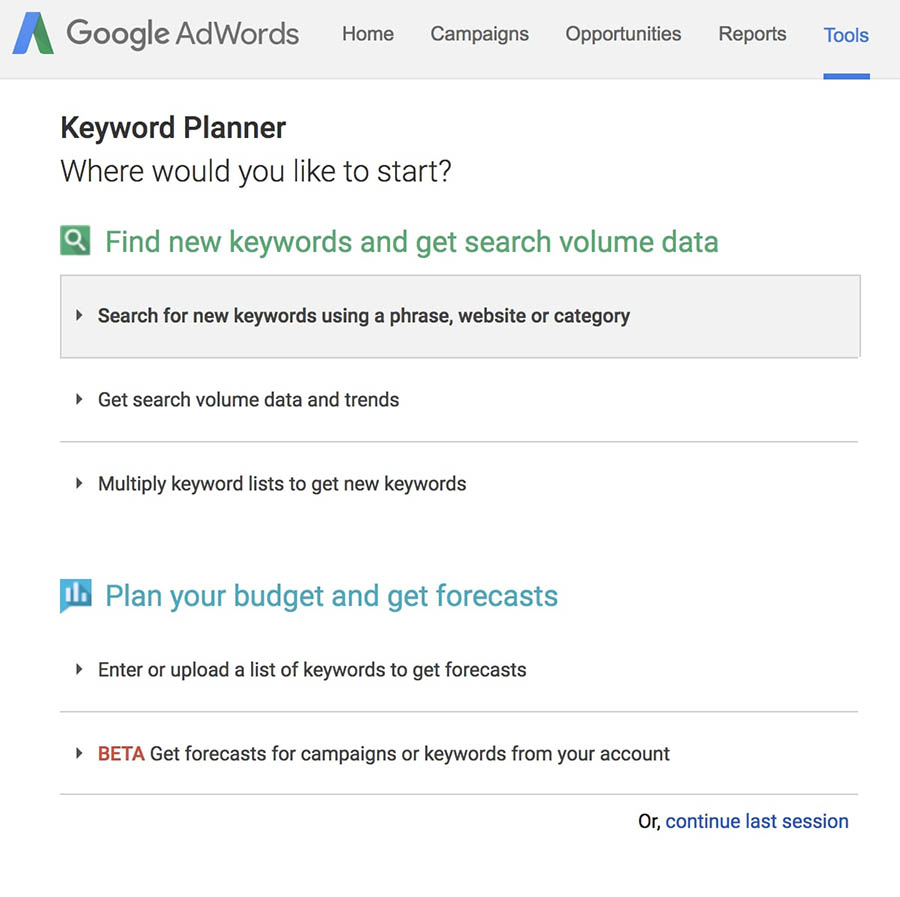 When you have your list of keywords, you can choose from different match types that dictate when your ad is displayed: exact match, phrase match, and broad match. Each type has its advantages and drawbacks, and your choice should be tailored to meet the needs of your campaign and your goals.
When you have your list of keywords, you can choose from different match types that dictate when your ad is displayed: exact match, phrase match, and broad match. Each type has its advantages and drawbacks, and your choice should be tailored to meet the needs of your campaign and your goals.
Exact match displays an ad when the search matches the exact term or close variations of that term. This is a good choice for marketers looking to target a very specific audience. It can also limit your traffic if you’ve very narrowly defined your reach.
Phrase match will display your ad if the search query contains the same order of words (it can also have additional words).
Broad match will display your ad when the search term contains any or some combination of the words in your keyword, in any order. Your ad could also show for other variations of the words, such as singular or plural forms, synonyms, etc. This opens the way for much more traffic, but the kind of traffic you’re getting could vary, because searchers may not find exactly what they’re looking for, making it less likely that conversions happen. So you’ll want to take caution with such a broad reach; you don’t want to waste your money on irrelevant searches.
You can also set keywords to a negative match, which allows you to keep your ad from being displayed when a given term is searched (set up with a minus sign, like -old, or -used). Using negative keyword matches can help better control relevance (by determining who not to target) without eliminating the potential traffic of broader match types. As with other matches, it may take time to refine, so continue to keep tweaking.
Whatever your match type, you’ll want to keep tabs on your Search Terms Report so you can evaluate the kind of search queries coming through, and adjust your search types to refine your keyword strategy. A good beginners option: start with phrase or broad match to drive traffic, then evaluate your results for converting keywords and adjust those to be set to exact match type. When all else fails, test! Your campaign will continue to need optimizing over time, so add and delete or change match types as best fit your needs.
2. Ads
How you craft your copy is critical to the success of your PPC campaign; your ads must be relevant enough to users’ searches to attract clicks. You’ll need to meet Google’s editorial standards, guidelines that dictate proper spelling, punctuation, image quality, and more. In addition to following the character limits for your ads (see below), you’ll want to deploy a few copy-crafting best practices — courtesy of Google itself:
- Take advantage of your limited number of characters. After all, you’re paying for the click. Make it an effective call to action (invite your customer to do something: buy, click, shop).
- Write for a mobile audience. Those customers tapping away on smartphone screens are an increasingly important group for you to appeal to. Craft ad copy with them in mind.
- Set yourself apart by delineating in your ad what makes you different and unique. One-of-a-kind inventory? Bonus incentive? Free shipping? Whatever it is, emphasize your competitive edge.
- Connect your elements. Increase relevancy (and your quality score — more on that later) by including at least one keyword in your ad and matching your ad to your landing page.
- TEST! As with most things on your website — and especially your marketing efforts — you’ll want to test your PPC ads. Google even allows you to test different versions of your ad; they’ll rotate through your ads to figure out which ones perform best.
How to Create an Ad
1. Log in to the Google AdWord’s site.
2. Select the type of campaign you want to run and then give it a name.
 3. Choose a goal — sales, leads, or website traffic (and more!) — and set other campaign details, like locations, bid strategy, and daily budget.
3. Choose a goal — sales, leads, or website traffic (and more!) — and set other campaign details, like locations, bid strategy, and daily budget.
4. Create your ad (there are different kinds, like display, video, search, or app ads), following the character-limit template:
- Headline 1: 30 characters
- Headline 2: 30 characters
- Description: 80 characters
- Path (2): 15 characters each
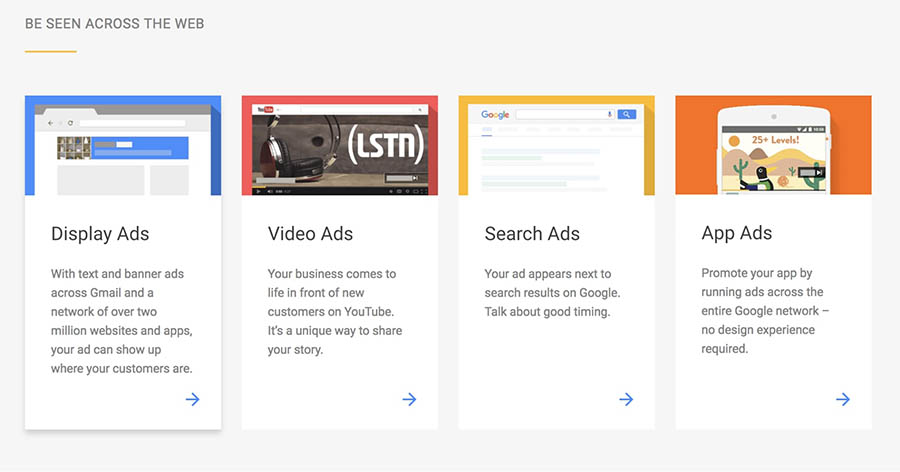
5. Select your keywords.
6. Set your cost per click.
7. Review details, and confirm billing information.
3. Landing Pages
When users click on your ads, they reach landing pages, which are a destination URL leading to a page on your site. Landing pages are intended to convert — to have users respond to your call to action by buying, engaging, subscribing, etc.
These landing pages should be targeted — whether they are product-specific or customized — so that you’re taking advantage of the opportunity of each click. Don’t make your visitors work for the information you promised (i.e. don’t send them to your site’s home page) or frustrate them with incomplete information. You want to do all you can to help them complete their purchases (hint: Google can help you test landing pages as well).
Don’t Forget Mobile
I know, I know. We talk about mobile all the time. But the stats don’t lie: 70 percent of mobile searches result in action being taken within an hour. As the use of mobile devices increase, it has become increasingly more important to optimize your campaigns for mobile searchers — and shoppers. This includes building responsive landing pages and writing tight, mobile-friendly ad copy.
Related: A Beginner’s Guide to Using Accelerated Mobile Pages (AMP) in WordPress
Understanding Quality Score
Next, you’ll need to understand how quality score influences your AdWords experience, especially as it has to do with relevancy between your landing pages, your ad copy, and your keywords. While your bid plays a major role in determining whether or not you received ad space for a keyword, Google also scans your content and utilizes an algorithm to determine your “Quality Score,” a score of relevancy between ads, your keyword, and your landing page content.
It can also help you to optimize keywords by determining which ones are cost-effective to use.
For example, if you find out that you have a low-quality score (it’s a 1 to 10 rating with 10 being the highest) when using a particular keyword, it means that the content on your site is not tightly related enough to your keywords, ad copy, and landing pages and, therefore, not relevant enough for Google in that space. With a high-quality score, Google will place your ad in a top position for a cost-effective price.
Ultimately, the quality score helps Google provide a better user experience. As it scans your content for relevancy, it ensures that you’re not buying keywords just to direct users to irrelevant pages.
Because, honestly, nobody wants to be directed to shiny pleather loafers (shudder) when what they were searching for was Air Jordans.
Measuring Your Success
As another thumbs up for Google AdWords: measuring your progress is simple. With easy-to-use tracking features, you can utilize the site’s metrics to optimize your campaigns. It’s like a one-stop shop for paid search. Here are the four main metrics you need to watch:
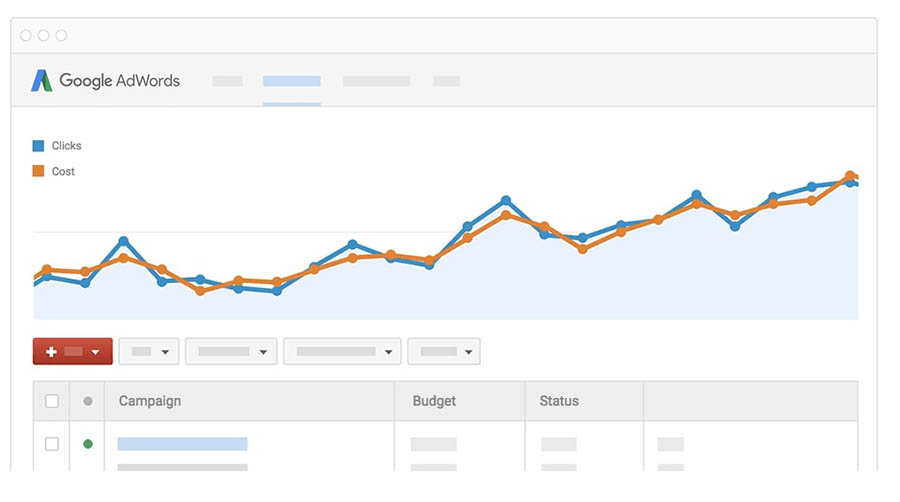
- Clicks: When users click on your ads.
- Conversions: When users respond to your call to action and engage. A tracking code can help you keep track of this number.
- Impressions: Instances of your ad being displayed when someone searches the keyword associated with your bid (roughly the number of people who look at your ad/the number of viewers the ad reaches).
- Spend: The amount of money you’ve spent on a campaign.
Also, be aware of these numbers, which involve the fundamental four metrics:
- Click Through Rate (CTR): The percentage of clicks that become conversions (the higher the number, the more effective your campaign). Determine this number by doing a little math: Clicks ÷ Impressions.
- Conversation Rate: The percentage of conversions per click. A successful campaign keeps this number low. Find the conversion rate with another simple formula: Conversions ÷ Clicks.
- Cost Per Click (CPC): The price you pay for each click is calculated by Spend ÷ Clicks. Your goal: decrease this number.
- Cost Per Acquisition (CPA): The amount of money you’re spending for each conversion. Spend ÷ Conversions. Again, try to keep this number low.
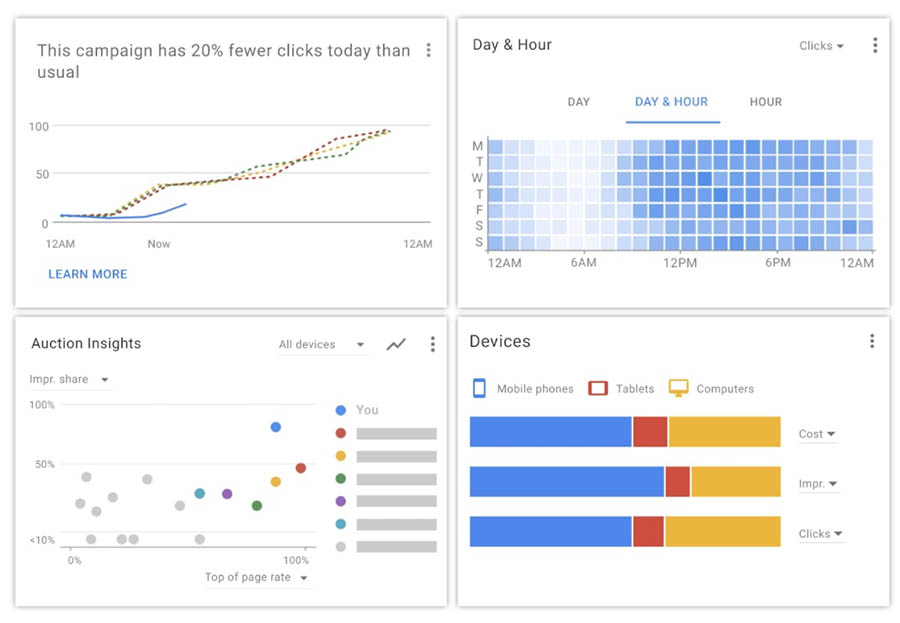
Once you start a PPC campaign, you’ll want to review these metrics regularly to look for ways to improve and optimize your campaign. By monitoring these metrics, you can make adjustments to keep performance high and costs low.
Last Clicks
With Google AdWords, savvy website owners like you can affordably get a PPC campaign up and running — whether you’re prepping for the holiday shopping rush or building a long-term marketing strategy for your business. The easy-to-use system helps you build an effective paid search advertising campaign to help grow your business.
Tell us: how has paid search helped your website grow? What are your best AdWords tips and tricks?
1 Comment
Comments are closed.
This step by step PPC campaign setting up guide is really helpful for beginners. In the advanced level there can be many things to take care of, but most important part is data analysis. Setting up one AdWords campaign is one thing but making it more profitable is another thing. This needs proper understanding of different data we get from AdWords reporting section or may be from Google Analytics tool.
But at a beginner level this post is really valuable. Anyone who wants to start working on PPC, this post is going to be helpful for them. I am going to share this post URL with all my PPC students and I hope they will like it.